Erin Driessen – 2 May, 2012
A major element of this exhibition is how each artist has approached and interpreted the history of the gallery. They have used their individual social memories in referencing the work of other artists who have previously exhibited at the Blue Oyster.
Dunedin
Darcell Apelu, Emma Febvre-Richards, Jacquelyn Greenbank, Lonnie Hutchinson, Jay Hutchinson, Sam Ovens, Motoko Kikkawa, Jill Sorensen
Silk and Lace: 13th Anniversary Gifts
Curated by Jamie Hanton
11 April - 12 May, 2012
Blue Oyster Gallery Director Jamie Hanton promotes in this exhibition the need to “embrace the unexpected and the disruptive, to expose the social relations behind a screen of curatorial objectivity. These relations are critical to the creation of personal and collective narratives in our lives and in the spaces in which we interact. Why then should they be prohibited in the gallery space?” The Blue Oyster is a fractured self, and Hanton recognises this. Across different artists, curators, directors, and board members, the visions and identities of the space are multiple. Yet one clear vision is evident throughout: confrontation. Silk and Lace confronts the past while staring the future in the face - much like any thirteen-year-old making the transition through childhood to adolescence.
A major element of this exhibition is how each artist has approached and interpreted the history of the gallery. They have used their individual social memories in referencing the work of other artists who have previously exhibited at the Blue Oyster. Apelu’s work is a conflation of the conceptual basis of Clare Fleming’s At once we are rootless and harbouring, floating on an inland sea (I am from here) and the material aspects of Colleen Altagracia’s The Fullness of Empty Pockets, both exhibited in 2011. It resembles a child’s crayon drawing; something a kindergartener might produce when asked to draw a picture of people of the world: a group of green, pink, purple faces with orange, blue, and red hair. A white circle surrounded by a swirl of brown hangs in the middle, perhaps representing Apelu’s Niuean and New Zealand identities. The title, Anxiety, speaks to the loose, frantic swirls of cotton thread as well as to a personal identity crisis. If these shapes are faces, they don’t stare back. They might be holes down which one crawls, searching and digging. The anxiety in this work is however tempered by the colour balance and symmetrical, circular formation of the pieces. Maybe all tunnels lead to the light of the face in the middle.
Febvre-Richards also chose Fleming’s 2011 work as a point of reference. She presents four lightboxes covered with laser cut paper. They take on various connotations throughout the viewing process: blueprints, maps, microchips, sewing patterns. I likened them to a Lite-Brite board, on which one places small plastic pieces into shapes or patterns that are back-lit by the lightbox. This practice of making and placing speaks to the idea of spatial memory in the context of an art gallery. The same space fosters hugely varied movements and interactions between viewers and artworks. Within the landscape-like patterns of the laser cuts, Febvre-Richards has attempted to place more artificial-looking squares. Nature meets culture, yet the relationship is fraught. The squares of space representing houses, institutions, or art spaces, don’t quite mesh with their surroundings. Yet, this may be the point. Personal and artistic identities overlap, and an attempt to separate them is an exercise in futility.
In the middle of the Upper Gallery sits a bizarre work. Greenbank’s Ghost fart is a piece of DNA. Its molecular structure of crushed velvet houses a pile of wool, beading, and cardboard that looks like natural forms of rock, moss, and grass. The work is heavy and lopsided, threatening to roll after you as you walk by. Greenbank stated the work was about her favourite experience of the Blue Oyster. After touring all the murder death sites in Dunedin, she and artist Jo Langford slept, or attempted to sleep, in the gallery. Ghost fart is a magnified cell which encloses the basic stuff of the blips in time that are our lives.
Lonnie Hutchinson has stated that Frocking is in dialogue with previous shows A Museum of Obsessions (2010) and Hello Lamb: The Perspectives of Elsewhere (2009). Clearly, the piece she exhibits here can be interpreted in different ways in the context of this statement. A Museum of Obsessions consisted of work made from the artist’s hair, self-portraits, private collections, and ethnic histories. Though Lonnie’s work is apparently less personal, the notion of obsession could be a connective thread, as her serial patterns cut into builder’s paper are meticulous. The New Zealand artists group Hello Lamb began with a DIY shelf, and The Perspectives of Elsewhere saw that shelf beginning to dematerialise, as works grew in size and scope and moved into other gallery spaces. Lonnie’s work seems to dissolve as the viewer’s eye moves downward, the glass box disappearing and black acrylic spilling off the wall onto the floor.
Jay Hutchinson’s I Thought You Loved Me Too references the work of Gary McMillan and Hayden Prujean shown at the Blue Oyster as part of the group exhibition Room in 2004. McMillan created a pencil on paper copy of an adult section of a newspaper, and Prujean performed a piece that included two strippers. Jay has embroidered ‘I love you’ three times onto digitally-printed silk representing a page from an adult section of a newspaper, crossing out the third with a single embroidered line. This hangs on the wall above a pile of other silk magazine pages on the floor. As usual these works are intricately made. Near these pieces, on the wall, are evidently the handprints of two strippers. At the exhibition preview, Jay had two strippers dance, reenacting Prujean’s performance. Jay prohibited photography, so these faint handprints are the only trace of the performance. Hanton has commented that the re-performance has led to re-tellings of the original story; apparently after Prujean’s performance there were loud rumblings of discontent among the Dunedin art community. Evident in Jay’s and other works here is the physical process of layering, an artistic expression of time and experience. A similar performance, exhibited eight years after the original, with all the art seen in between, still has the power to evoke strong responses. The Blue Oyster is still confronting.
Sam Ovens in turn references Jay’s exhibition from 2007, Made at the Sweatshop. A performance-based exhibition, Sweatshop was a physical model of sweatshop conditions and aimed “to unalienate [sic] consumers from the processes of production and help them to understand the actual value of the labour that is invested.” Jay worked four days per week at the Blue Oyster Gallery creating screen-printed t-shirts, then pricing them based on the actual cost of materials, and labour priced at ten cents per hour. Ovens extends the theme of exploitation in eight of his silkscreen printed t-shirts, all of which contain the word ‘sweat.’ Individually titled, they show scenes of a violent and/or pornographic nature. For Ovens, they are relatively tame. The eight hang together and seem to merge into one artwork, with the design extremely tight and sophisticated. Ovens’ t-shirts are not sweatshop t-shirts; they are fine art. The artist highlights the sometimes uneven and fickle nature of the art world, as the same products are completely defined by the different contexts in which they are made and displayed.
Motoko Kikkawa exhibits a photographic print of a work she made for a previous exhibition of hers entitled Money That We Can’t Use Here. The actual work was a Victorian lace collar made from single grains of rice glued together. It was originally exhibited at Dunedin artist-run space Rice and Beans. By choosing to show a work not influenced by the Blue Oyster archives, but related to another Dunedin gallery, Kikkawa aims to foster the relationship between different art spaces in Dunedin and by extension New Zealand. It being a photograph, Rice Lace also highlights the issue of re-presentation. As time passes, individual artworks and exhibitions as a whole are remembered differently, their origins blurred by the process of story-telling and the compounding of interpretation through discussion and hindsight. From original, to photograph, to memory, artworks are malleable.
Performance and installation also come together in Jill Sorensen’s work. On the day of the exhibition preview, Sorensen took to the Octagon in Dunedin with a handful of hydrangeas. Advocating and supporting peaceful protest, she handed them to members of the Occupy Dunedin movement. Spectators were invited to lay flowers in a huge cross formation that traversed an intersection, the same intersection that Sylvia Schwenk used in her 2009 work X Performance Dunedin. Schwenk used people instead of flowers, thus stopping traffic. Sorensen’s seems to have less of an interruptive element and more of an incorporative one. After the one-off performance, Sorensen stenciled icing sugar into lace patterns on the floor of the Blue Oyster, right under the archway. The movements of gallery visitors were traced in white dust. As the icing sugar was spread around the space, its bottom layer remained and the lace pattern was still remarkably discernible after two weeks. There was always a truth, a form, a material, that remained fixed.
Each of these works confronts the potential falsehoods and blind-spots created by selective memory. The exhibition as a whole advocates the need for confrontation and dialogue in a local and national art world sometimes deemed too insular and cosy. This interrelatedness can involve artists deliberately referencing and consciously messing with the work of other artists. However, does a potentially circular practice like this only serve to mollycoddle and pat each participant on the back, further insulating or stunting Dunedin and New Zealand-based art?
I don’t think so. It’s saying, you can touch this, you can have this, you can do what you like with this. A direct confrontation between artists and previous work, mediated through histories and archives, promotes a toughness and knowledge beneficial to the future of any art community.
Erin Driessen
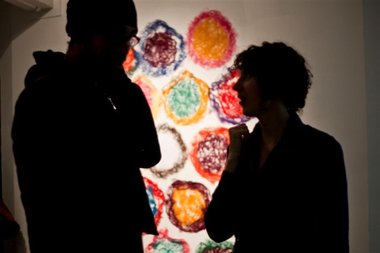



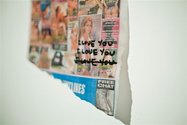
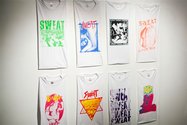
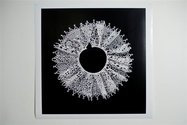
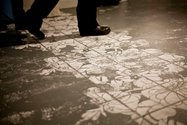
 Advertising in this column
Advertising in this column Two Rooms presents a program of residencies and projects
Two Rooms presents a program of residencies and projects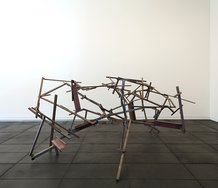
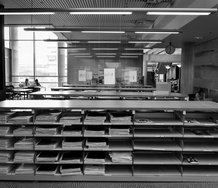
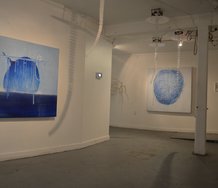
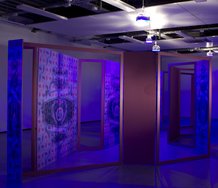
This Discussion has 0 comments.
Comment
Participate
Register to Participate.
Sign in
Sign in to an existing account.